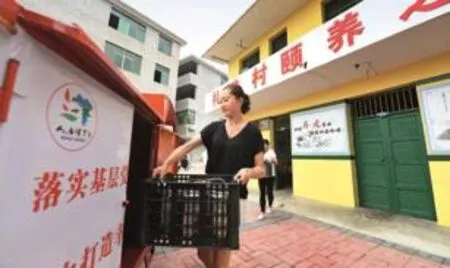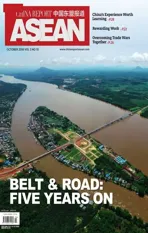EXPLORING JIANGXI’S VILLAGE REVITALIZATION
2018-11-05ByJiangXuan
By Jiang Xuan

The picturesque scene of a hybrid rice seed production base in Jiangxi.
Since the beginning of summer, several cities and counties have adopted a lotus theme when organizing a variety of tourism and cultural activities to invigorate the local tourism market, attract investment and create new opportunities such as the “ flower economy”for village construction. This is the blueprint for revitalization of rural areas in Jiangxi Province in southeastern China.
Jiangxi still has a large proportion of agricultural workers living across an expansive rural area, and agriculture remains crucial to the livelihood of many residents.
Liu Qi, secretary of Jiangxi Provincial Committee of the CPC, declared: “Agriculture industrialization is the main force driving the modernization of agriculture and rural areas,and prosperous industries are a key component of village revitalization. We have to push the agricultural supply-side structural reform,optimize the industrial structure of agriculture and advance agriculture towards high quality development to promote Jiangxi’s transformation from a large agricultural province to a strong one.”
Building Prosperous Villages
In March, Jiangxi issued Opinions on Implementing the Strategies of Village Revitalization,which states that the provincial government will spare no efforts to make agriculture strong,villages beautiful and farmers well-off. At the same time, Jiangxi will make agriculture a burgeoning industry, make farming a more attractive occupation and ensure villages are attractive places to live and work.
Agriculture industrialization is a key component of village revitalization. Jiangxi has decided to accelerate the development of modern agriculture and boost agriculture and rural economy.Against the backdrop of deepening the agricultural supply-side structural reform, Jiangxi will pursue a road to revitalizing rural areas towards high quality development through insisting on efficiently stabilizing grain production to supply higherquality food products.
Jiangxi has successfully transformed its characteristic resource advantages into economic advantages. The province has fostered several famous brands of flower festivals and large-scale agriculturalproduct-themed activities including the Cole Flowers Festival in Jiangling,Wuyuan County; the Cherry Blossom Festival in Fenghuanggou, Nanchang County; the Tangerine Cultural and Tourism Festival in Nanfeng County;Guangchang International Lotus Festival in Fuzhou; and Huayuangu Flora Worship Festival in Wuning County.
In Wuyuan alone there are more than 260 registered farmer cooperatives. The average farmer receives about 1,500 yuan (US$219)from the tourism market, and the annual gross output of the “ flower economy” for Wuyuan is more than 1 billion yuan (US$0.15 billion).
Accelerating Agricultural Modernization
In the process of implementing strategies for village revitalization,agricultural authorities at all levels in Jiangxi have promoted agricultural supply-side structural reform and made efforts to establish nationally famous supply bases for organic produce, ushering in a healthier era for the province’s agriculture and rural economy.
Liu Qi revealed that Jiangxi has witnessed 14 consecutive years of bumper grain harvests.Green agriculture achieved new breakthroughs as the quali fication rate of major agricultural products has stayed above 98 percent for five years in a row. Infrastructure has improved by leaps and bounds. The industrial technology system for modern agriculture and the construction of intelligent agricultural platforms have constantly improved. Farmers’incomes increased, and per capita disposable income of rural residents was 13,242 yuan (US$1,937) in 2017, up 9.1 percent compared to 2016.

Jiangxi has continued to improve the quality of agricultural development and comprehensive bene fits by optimizing agricultural structures. The province has launched projects promoting the development of nine sectors, namely high quality rice, vegetable, fruits, tea,Chinese herbal medicines, herbivorous animal husbandry, aquaculture, tea-oil trees, and recreational agriculture and rural tourism.
In 2018, the province’s cultivated area of early season rice remained stable and crops ripe in spring resulted in a bumper harvest. Its beef and mutton yield accounted for 6 percent of the total Chinese meat output, and the output of special aquatic products increased. Construction of farmland facilities has made steady headway,and with 5,299.7 hectares of newlyadded arable land, the province introduced and cultivated more than 10,000 modern farmers and farming cooperatives which have bene fited 68,000 needy families.
Jiangxi emphasizes developing high-quality green agriculture. The province has accelerated construction of demonstration bases for nationally famous organic agricultural products and recently applied to register 38 local agricultural standards, 112 organic foods and four agricultural base areas. And the quali fication rate of major agricultural products has reached 98.4 percent. Jiangxi introduced a demonstration project of Public-Private Partnership to fully implement intelligent agriculture.So far, Jiangxi has built more than 40 various agricultural technological innovation platforms and 20 industrial technology systems. A total of 5,000 various recreational agriculture-themed businesses were tallied in Jiangxi in 2017, an increase of 9.4 percent over 2016.

Farmers busy harvesting early rice in Jiangxi.
Jiangxi has propelled an upgrade to modern agriculture to raise farmers’ incomes. The province considers technological innovation and new business forms sources of economic growth to promote the development of new industries and new businesses. In the first half of 2018, sales revenue of leading enterprises above designated size in Jiangxi increased by 8 percent yearon-year, and the figure of provincial leading companies was up 7.9 percent compared with the same period of 2017. Jiangxi has designated 159 provincial-level modern agriculture demonstration parks and 38,300 family farms and cultivated more than 110,000 professional farmers.In the first half of 2018, per capita disposable income of rural residents was 5,928 yuan (US$867), an increase of 9.2 percent year-on-year.
Jiangxi has been accelerating the transformation from a large traditional agricultural province to a modern agricultural province.Since the beginning of 2018, a cloud platform for agricultural Internet of Things has been accessed by 200 enterprises and bases in Jiangxi to utilize real-time data and video transmission. The Department of Agriculture of Jiangxi Province used 16 million yuan (US$2.3 million) to build demonstration areas for agricultural Internet of Things in five key modern agricultural parks across the province.
Since 2017, nearly 20 sub-systems began operating online including a fishery administration command and dispatch system, a soil testing and fertilization management system and animal quarantine and electronic certi ficate systems. Jiangxi has also launched a program to enable information technology be accessed to rural families. So far, the province has built five city-level operations centers, 80 county-level e-commerce operations centers for agricultural products and 7,200 information cooperatives for farmers.
Activating Village Resources
“The fundamental objective of village revitalization is to improve farmers’living standards,” stressed Liu Qi. “We will accelerate the pace of lifting farmers out of poverty, improve production and living conditions for farmers, promote allocation of public resources to the countryside and continue improving farmers’ well-being.”
Jinshun Village, located in Hufang Town of Nanchang, the capital of Jiangxi, is a typical urban village. In 2017, the village collectively earned more than 9.2 million yuan (US$1.3 million) in share dividends, averaging 6,200 yuan (US$907) per capita and 20,000 yuan (US$2,925.8) per household. Party Secretary of Jinshun Village Luo Laichang remarked that good economic returns have been fueled by reform and opening up,which inspired the village to utilize its geographical advantages to vigorously develop rural industries.

More than 500 villagers watch a performance of traditional opera in a cultural center.

A village official loads lunch boxes for seniors on a delivery car.
“Realizing village revitalization requires support from industry,”noted Luo Laichang. Jinshun Village is building a modern logistics system, developing ecological agriculture tourism and health care and accelerating construction of an integrated development system for primary, secondary and tertiary industries in rural areas to enable more farmers to bene fit from reform.
Lin Yinsun, chairman of Zhengbang Group Co., Ltd., the largest agricultural company in Jiangxi, noted that without supportive industries, agriculture is less attractive, farmers earn less and rural areas lack vitality. In order to supply the necessary materials for booming industries, agricultural enterprises must play a leading role.In Lin’s opinion, local governments should guide and support agricultural companies to implement the strategy of village revitalization.
Jiangxi has bene fited from activating various resources and promoting industrial development.For instance, Shangrao City in northeastern Jiangxi has improved agricultural scale operations and vigorously promoted construction of modern agricultural demonstration parks in recent years. Today, it is home to 68 agricultural industrial parks producing gross output of more than 14 billion yuan (US$2.05 billion).At the same time, Shangrao has made efforts to advance collective village economic development. In 2017, some 60 percent of administrative villages in Shangrao broke even or better.
Building Beautiful Villages
Jiangxi has endeavored to strengthen ecological protection in rural areas and promote construction of new countryside under the theme of “neat, beautiful, harmonious,habitable,” laying a solid foundation for the establishment of a “Jiangxi model” to showcase a beautiful China.
Jiangxi has advanced a fouryear action plan to construct new countryside, emphasizing modi fication of roads, waterways,toilets, houses, ditches and ponds as well as promotion of environment improvement, stronger power networks and better access to radio,televisions and the internet. By 2020, all this work will be essentially complete to meet rural residential demand for a habitable environment.
At the same time, the province has also waged a campaign against agriculture-sourced pollution, with focus on developing green ecological agriculture, minimizing usage of pesticides and fertilizers and protecting the environment in which agricultural products are produced. According to the law, straw is prohibited from burning in the open air and is encouraged to be used as fertilizer, raw material, energy and fodder.
For instance, Yujiang District in the city of Yingtan has promoted three pilot reforms of rural land system such as a national rural homestead system, which will catalog reform achievements and practical experience that can be reproduced and promoted to improve living standards in other places in China.Meanwhile, considering homestead system reform an opportunity,Jiangxi will vigorously promote the development of modern agriculture,standardized infrastructure,equalization of public services and the construction of beautiful villages.Jiangxi is also brainstorming methods to transform migrant workers into city dwellers and standardize rural governance to strengthen the process of pilot reforms.
Yujiang County Chief Su Jianjun illustrated that reform of the rural homestead system will also be bene ficial to village revitalization in terms of de fining collective property rights, developing the collective economy, granting homestead management rights, increasing farmers’ incomes, enhancing collective governance, introducing rural professionals and cultivating a workforce with knowledge of rural areas, farmers and agriculture. This will advance the overall development of the countryside.
